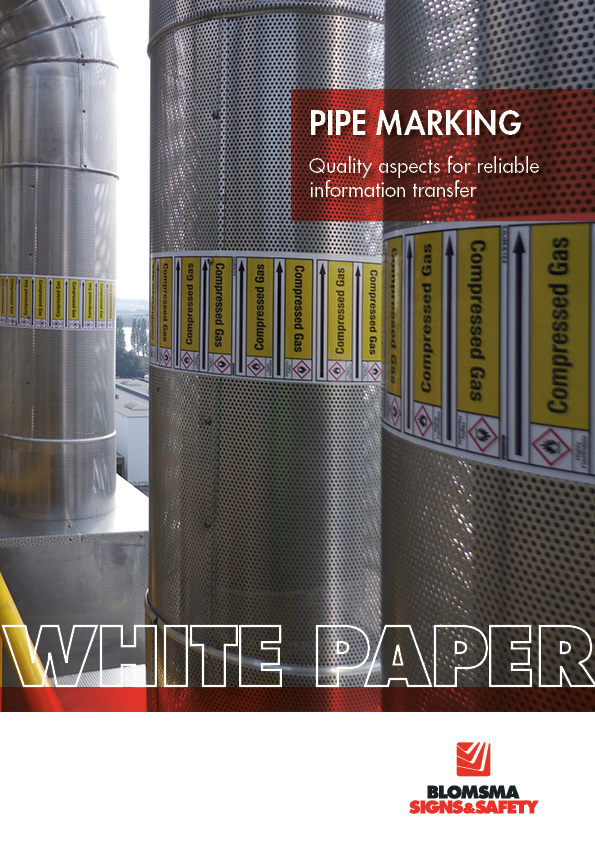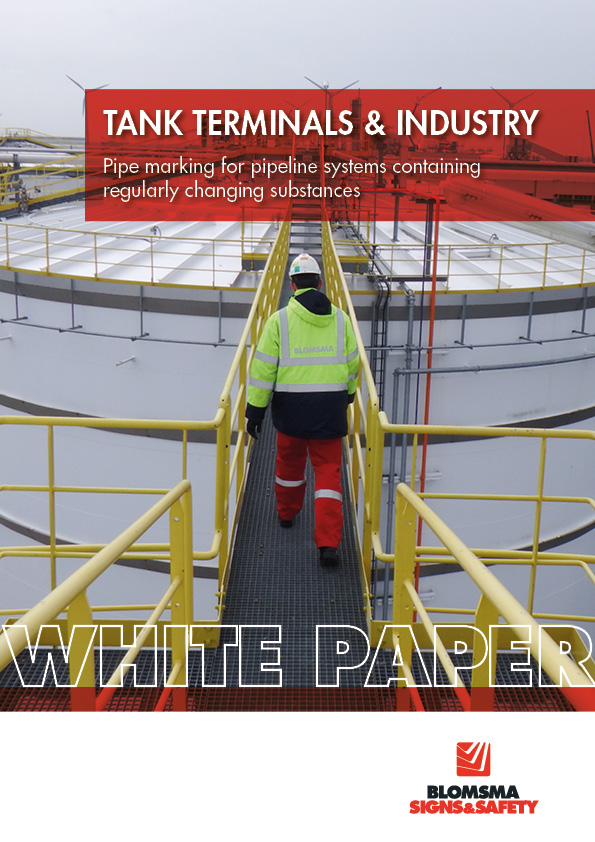PolyesPro® Pipe Marking
Top quality pipe marking developed in cooperation with 3M
Pipe marking is a visual communication tool to identify the function, content and flow direction of pipes. Pipe marking is a safety information system and supports proper management and maintenance of the pipe system. Pipe marking also provides for the display of critical information for trained personnel and professionals in emergency situations.
Pipe marking is primarily used to indicate hazardous substances in pipes to prevent incidents. In addition, non-hazardous materials such as utility systems (air, steam, water, etc.) can be marked in a similar style. By not only marking pipes with hazardous substances but also utility pipes, the entire process becomes clear and therefore comprehensible. Incidents are prevented because the absence of unmarked pipes means there is no doubt as to whether they contain hazardous substances. After all, even pressurized steam or air pipes pose risks. During operational and maintenance activities piping marking contributes to safety by providing insight into the installation.
We offer a range of pipe marking services tailored to your specific requirements. From simply purchasing the pipe markings to a complete project-based implementation, our four service packages offer flexible and tailor-made solutions. You choose how we will help you with your pipe marking project:
We provide:
Supply of materials
Creation of layouts
Optional application instruction
You provide:
Information on the contents
Required quantities and types
Installation of the markings
Compliance with legislation
We provide:
Supply of materials
Creation of layouts
Application of markings
You provide:
Information of the contents
Required quantities and types
Pre-coding and/or guidance
Compliance with legislation
We provide:
Site survey
Assistance in drawing up a contents list
Pre-coding material
Supply of materials
Preparation of layouts
Compliance with legislation
Planning and implementation support
Application of the markings
You provide:
Detailed info of the piping systems
Information on the contents
Pre-coding
Internal contact point
We provide:
Site survey or from 3D model
Preparation of contents list
Pre-coding
Supply of materials
Creation of layouts
Compliance with legislation
Planning and implementation support
Application of the markings
Optional integrated process information
Optional maintenance cycle
You provide:
Detailed info of the piping system
Information on the contents
Internal contact point
“A safety information system for piping visually communicates information necessary for the reliable recognition, identification and understanding of any hazard related to the type and character of the content of a pipe” – ISO 20560-1
MEER OVER ISO 20560In almost all countries there are laws and standards that require pipelines carrying hazardous substances to be marked. These markings are part of the health and safety signs that must be present in the workplace. These markings contain information that contributes to the safety of employees, contractors and emergency services during normal situations, maintenance programs and uncontrolled situations. It should therefore be possible to assume that this information is always available; recognizable and legible.
Recognizability is determined by strategically placed markings, format and design. At least as important is color; there are norms and industry standards that assign colors to piping systems and substance groups. This increases recognizability, and one is not just dependent on a text for legibility. The most important standards for this are the ISO 20560-1; a global standard to bring consistency to the marking of piping and the ISO 14726 for shipping. Other regularly used standards include the DIN2403 (Germany), ASME A13.1-2015 (USA), BS1710 (UK) and the NORSOK L-004 (offshore Scandinavia).
The Globally Harmonized System (GHS) is a globally harmonized system for the hazard classification of substances. GHS contains nine hazard pictograms which are used for the labeling of chemical substances and mixtures. These must be applied as part of a pipe marking on storage tanks and pipes. The United Nations (UN) developed GHS. The GHS has largely been implemented in international transport regulations. The hazard classification for the supply and use of substances and mixtures in the EU is also in line with the GHS. To this end, the CLP Regulation (EC) 1272/2008 came into force in 2009. This regulation replaced the Substances Directive 67/548/EEC and the Preparations Directive 1999/45/EC.
Our pipe marking contains the color code for the type of medium, the flow direction(s), GHS hazard pictograms and texts that describe the medium and can be read from any position. This ensures that the medium and any risks are recognized at a glance. By using durable materials and GHS pictograms, your pipe markings are future-proof.
ISO 20560 is an international standard for pipe and tank marking. This global standard provides guidelines and recommendations for identifying and marking pipes and tanks. ISO 20560-1 focuses specifically on pipe marking while ISO 20560-2 focuses on tank marking.
ISO 20560 is a global standard that ensures consistency to make the process of pipe marking and tank marking as clear as possible and to optimize workplace safety.
You can read more about ISO 20560 here.
While ISO 20560 is an important standard, it is important to note that local, national, or regional rules and laws may also apply when marking pipes. These rules and laws can vary depending on the jurisdiction, industry, and application of pipe marking.
For example, in Germany, there are specific rules and regulations for pipe marking of gas pipes and water pipes, found in the TRGI (Technical Rule for Gas Installations) and TRWI (Technical Rule for Water Installations). The United Kingdom also has specific regulations for pipe marking, included in the Health and Safety Regulations 1996. In France, there is the ‘Code due Travail’, which also contains regulations regarding pipe marking.
At Blomsma Signs & Safety, we always ensure that your pipe marking complies with all applicable laws and regulations, and with ISO standards such as ISO 20560, ISO14726, and DIN2403.
There are factors that can cause quality problems in pipe marking. Factors that influence not only the quality of the pipe marking but also the influence of pipe marking on your pipes. Blomsma Signs & Safety, in close cooperation with 3M™, has developed its own product line for pipe marking. You can read more about PolyesPro® pipe marking on this page and download the PolyesPro® datasheet here.

In our white paper 'Pipe marking, quality aspects for reliable information transfer', we describe the most common problems surrounding the quality of pipe marking and also show you how it can be done.
Download white paperThere are many questions from the tank storage sector about the usefulness of marking all piping systems. This is partly due to a practical challenge: the content of tanks and pipelines changes on a regular basis. In practice, this continuous process means that operators are occupied daily with adapting markings on pipes and tanks to the product present at that moment. In terms of work, this means that markings must be made or ordered, old markings removed and new ones applied. At terminals with a substantial pipeline network, this means a lot of work, work that is not directly linked to the productivity and efficiency of the terminal. The laws and regulations certainly offer opportunities to take a pragmatic approach to the implementation and positioning of pipe markings for optimal identification of your process.

In our 16-page white paper called 'Pipe markings on pipe systems with regularly changing media' you can read all about the problem definition and risks, legal requirements, standards and practical solutions.
Download white paperWhen applying pipe markings it is important that they are done in the correct position. From a legislative point of view, these are primarily the locations where substances can be released, such as at valves, flanges and appendages. Furthermore, the markings must be repeated sufficiently. In complex pipeline systems or manifolds where many pipes converge we apply the markings in line. This creates a calm and therefore orderly image. Blomsma Signs & Safety realises pipe markings as a safety signalling system which at least complies with legislation, displays the necessary information recognisably at relevant positions, is of high quality in terms of material and application and above all is economical and manageable.
We attune the use of materials to the application, environment, the material substrate and the desired life span. Blomsma Signs & Safety uses durable products, the most common with a 3M™ guarantee of 5 years. Virtually all our markings are provided with a base chemical-resistant, dirt-repellent and UV-inhibiting laminate.
Our global teams of engineers and 3M™ Certified Safety Sign Installers™ complete turn-key projects, modification projects and pipe marking maintenance.
Blomsma Signs & Safety has years of experience in the realisation of pipe marking for optimal identification of your process in the (petro) chemical industry, offshore sector, pharmaceuticals, food, raw materials and manufacturing industry as well as water treatment plants and energy and waste processing plants. From a complete refinery to an HVAC installation in a health care center, we offer a suitable solution and approach for each project. Our professionals use P&IDs and pipe lists, among other things, to determine where pipe markings are needed. During the work we can also carry out a check on the P&IDs supplied so that at the end you immediately have the current as built information. There are also project forms possible in which operators are involved in the project by assisting in the identification and pre-coding of the pipes.
We supply materials and realize (turn-key) projects for:
Top quality pipe marking developed in cooperation with 3M
An overview of our brochures, portfolios, white papers and certificates.
Tank marking hazardous substances
An overview of our projects in industry & chemistry, offshore & marine and utility.
An overview of our latest news items
Want to know more?
Contact us.